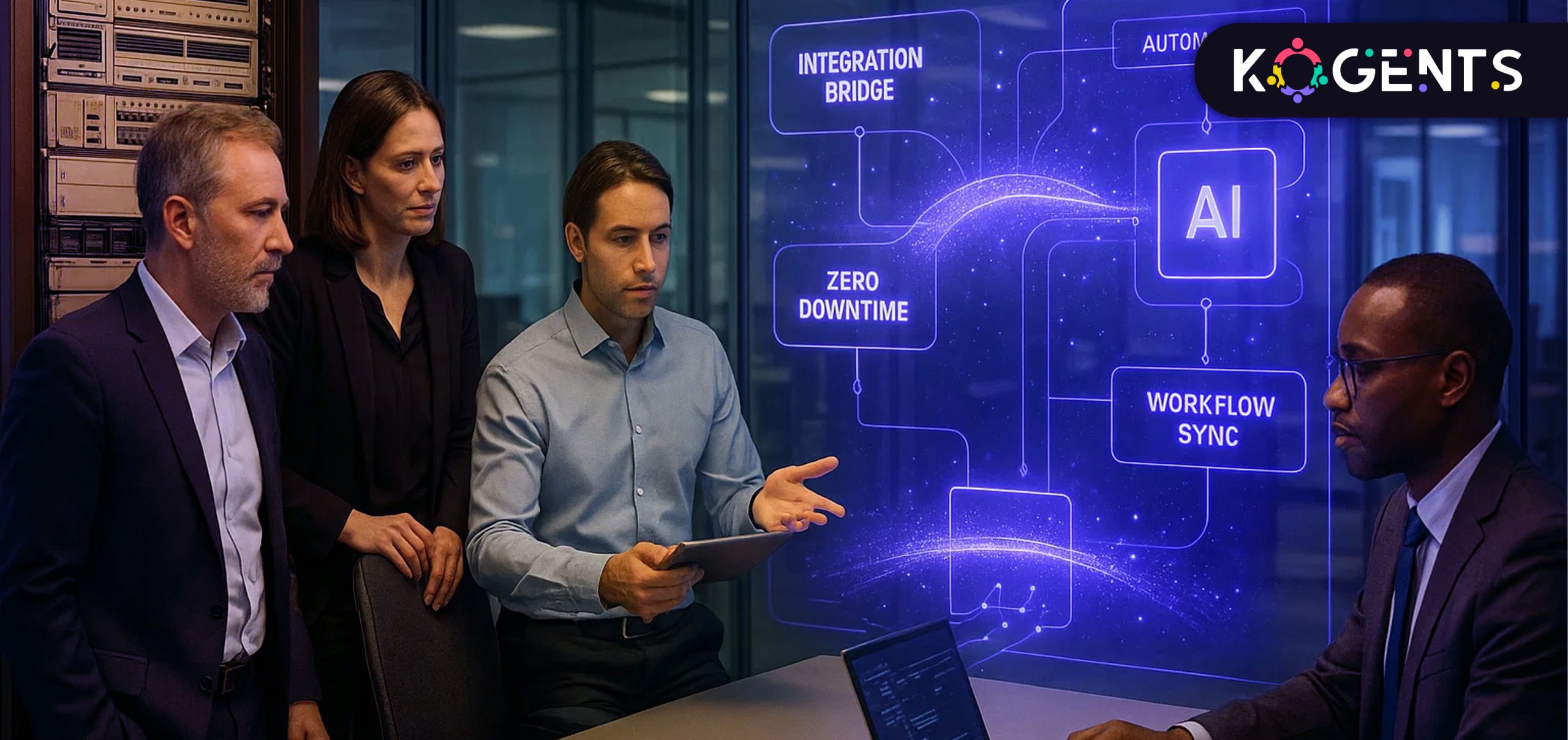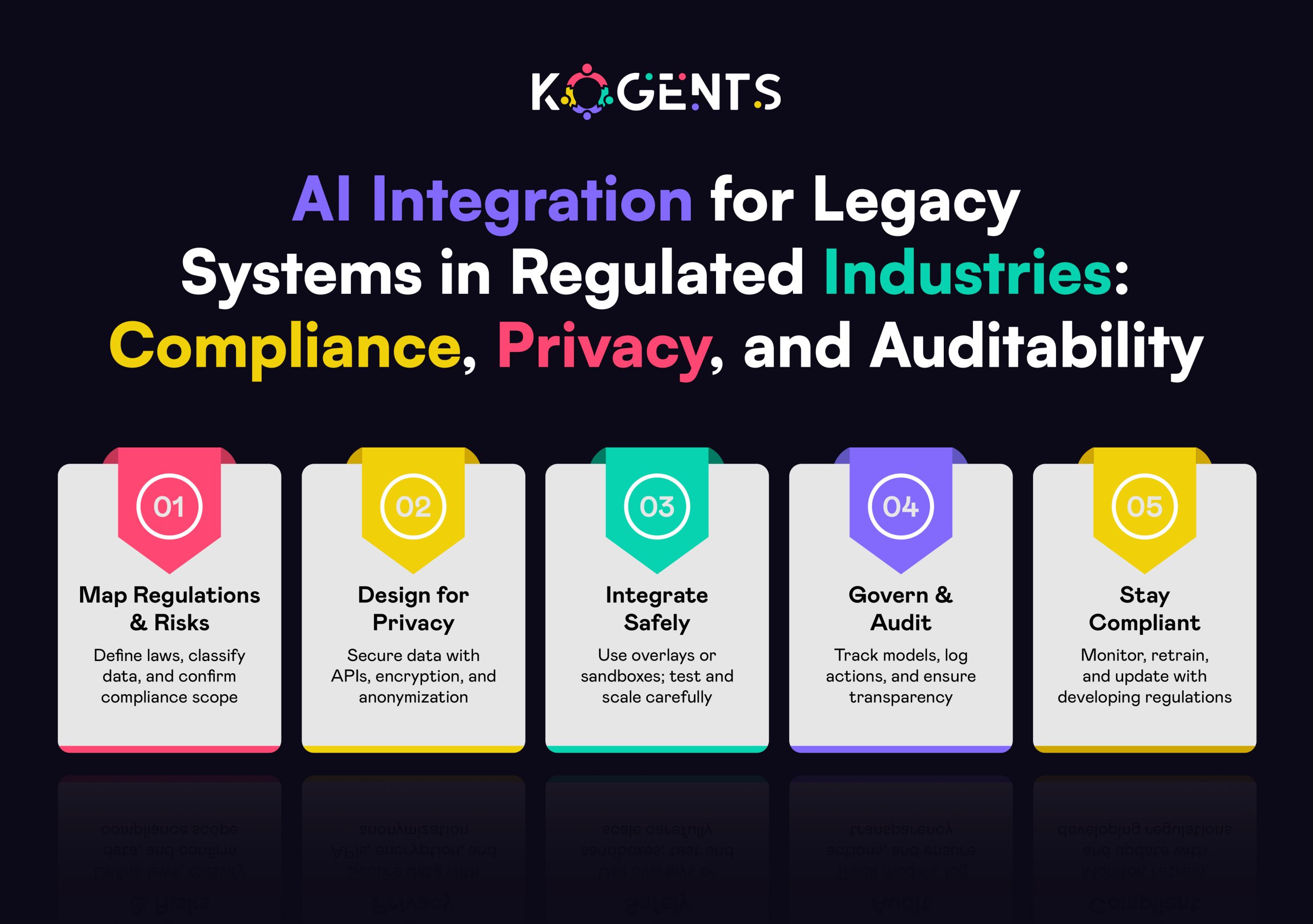AI Integration for Legacy Systems Without Disrupting Critical Enterprise Workflows

Summary:
In the modern enterprise, agility isn’t just an advantage but survival. Yet, many global organizations still depend on legacy systems built decades ago.
From COBOL-based banking software to monolithic healthcare databases, these systems handle mission-critical operations, but they also constrain innovation, scalability, and speed.
The challenge: how can you bring artificial intelligence (AI) into such fragile ecosystems without breaking workflows that millions rely on daily?
The solution isn’t a “rip and replace.” It’s AI integration for legacy systems, a layered modernization approach that preserves stability while infusing intelligence, automation, and predictive analytics.
Done right, this strategy transforms rigid infrastructures into adaptive, insight-driven platforms, without a single day of downtime.
This guide explores how to execute that transformation. So, let’s uncover how to evolve your enterprise systems from legacy-bound to AI-powered, securely, incrementally, and intelligently.
Key Takeaways
- AI integration modernizes without disruption.
- Prioritize architecture, not just AI models.
- Pilot, measure, iterate, and govern continuously.
- Treat modernization as an enterprise-wide evolution.
- With structured planning, legacy doesn’t limit innovation; it fuels it.
Strategic Insights At A Glance
- Legacy ≠ Liability. Treat legacy systems as strategic assets with rich data and proven logic; AI should augment, not erase them.
- Continuity is King. Modernize incrementally using hybrid overlays and sandbox pilots that preserve uptime.
- Architecture Over Algorithms. Focus first on data readiness, APIs, and interoperability before deploying models.
- Governance Before Genius. Compliance, data lineage, and explainability must precede scaling.
- Hybridization Wins. Combine legacy cores with cloud-based AI microservices and automation overlays to achieve agility without chaos.

Why AI Integration for Legacy Systems is a Business Imperative?
AI integration offers a smarter path: enhancing existing systems rather than dismantling them and replacing them outright is often risky and cost-prohibitive.
Many enterprises also ask, “How much does it cost to build an AI system?”, but the truth is that integration often delivers higher ROI at lower cost compared to a full rebuild.
Benefits include:
- Unlocking siloed data for real-time analytics.
- Embedding intelligence through predictive models and process automation.
- Reducing technical debt via AI-driven refactoring and dependency mapping.
- Maintaining compliance and audit trails during transformation.
Note: With AI integration with legacy systems, organizations can modernize without stopping the business clock.
Architectural Frameworks & Real-World Modernization Models
AI-driven modernization isn’t one-size-fits-all. Here are the five leading architectural frameworks enterprises use to modernize intelligently:
1. Overlay Integration (Minimal Disruption Model)
- Concept: Layer AI microservices over legacy systems via APIs.
- Example: A global bank adds AI-powered fraud detection through an API connected to its legacy transaction system.
- Suggestion: For teams exploring how to create an AI agent from scratch, this framework offers a foundation, showing how modular AI agents can interact with legacy APIs safely and effectively.
- Benefit: Non-intrusive, quick to deploy, zero downtime.
2. Modular Refactoring (Evolutionary Model)
- Concept: Break legacy monoliths into microservices, modernizing each component with AI.
- Example: A logistics firm adds an AI forecasting agent to its refactored order module.
- Benefit: Gradual modernization without full rebuilds.
3. Hybrid Cloud Integration (Elastic Model)
- Concept: Shift select workloads to the cloud while legacy data remains on-prem.
- Example: Healthcare providers run AI diagnostic models in the cloud using anonymized EHR data from on-prem systems.
- Benefit: Flexible scaling, lower infra cost, minimal risk.
4. Automated Code Modernization (AI-First Model)
- Concept: Use AI tools to analyze and refactor code automatically (COBOL → Java).
- Benefit: Faster modernization with less human intervention.
5. Digital Twin Environments (Risk-Free Sandbox)
- Concept: Create a digital replica of your system to test AI integrations safely.
- Benefit: Zero-risk experimentation and rapid iteration.
| Framework | Disruption Level | Integration Speed | Ideal Use Case |
| Overlay | Minimal | Fast | Continuous workflows |
| Modular Refactoring | Medium | Gradual | Modular systems |
| Hybrid Cloud | Low | Moderate | AI analytics |
| Automated Refactoring | Medium | Fast | Code conversion |
| Digital Twin | None | Iterative | Safe AI testing |
Step-by-Step: Achieving AI Integration Without Disruption
Modernization through AI should feel like evolution, not surgery. Here’s a detailed six-step blueprint for intelligent, disruption-free transformation.
Assess Your Legacy Footprint
- Every modernization journey begins with visibility.
- Most legacy systems contain undocumented dependencies and brittle code that can collapse under pressure if not mapped.
Actions to take:
- Catalog all systems, databases, and batch jobs.
- Map mission-critical workflows (billing, HR, compliance).
- Identify outdated frameworks, unsupported code, and security gaps.
- Use AI-based discovery tools (CAST Highlight, IBM Watson AIOps) for automated dependency analysis.
Outcome: A full “digital MRI” of your ecosystem, pinpointing what’s stable, what’s risky, and what’s integration-ready.
Build an AI-Ready Data Architecture
Data is the lifeblood of AI, but legacy systems often store it in silos or outdated formats.
Actions to take:
- Clean, classify, and standardize all data sources.
- Deploy data pipelines using Snowflake, Databricks, or Apache NiFi.
- Establish metadata management and lineage tracking.
- Introduce real-time data streaming (Kafka, Pulsar) for live analytics.
- Secure and anonymize sensitive data per GDPR/HIPAA.
Outcome: Unified, AI-ready data pipelines that enable automation and decision-making without manual effort.
Deploy Middleware/API Layer for Interoperability
- Think of this as a “translator” between your old and new systems.
- Middleware enables the AI and legacy application integration you need for smooth communication.
Actions to take:
- Implement integration platforms like MuleSoft, IBM App Connect, or WSO2.
- Wrap legacy functions as RESTful APIs for modular access.
- Standardize data formats and implement rate limits.
- Use monitoring tools to track latency and prevent overload.
Example: A manufacturer uses APIs to connect a legacy ERP with an AI engine for predictive supply-chain analytics, without changing the core ERP logic.
Pilot with a High-ROI Workflow
- Start where risk is low and value is high.
- This validates the approach while maintaining operational safety.
Actions to take:
- Choose a contained process—e.g., invoice automation, demand forecasting, or customer query handling.
- Define measurable KPIs: speed, cost reduction, and accuracy.
- Run parallel operations (AI + legacy) for comparison.
- Measure gains and gather stakeholder feedback.
Outcome: A tangible proof-of-concept showing AI’s impact, paving the way for enterprise-wide adoption.
Measure KPIs & Iterate Continuously
- AI integration is iterative.
- Constant performance measurement ensures you’re improving, not just changing.
Actions to take:
- Define dual KPIs: technical (latency, uptime) and business (ROI, error reduction).
- Track metrics with observability tools like Grafana, Datadog, or Prometheus.
- Feed back real-world data into models for retraining.
- Create executive dashboards to visualize progress.
Outcome: Continuous optimization cycle, every iteration makes systems smarter, faster, and more reliable.
Scale with Governance and Compliance
- As AI expands across your enterprise, governance becomes your anchor.
- Poor oversight risks data breaches, bias, and compliance violations.
Actions to take:
- Implement model governance (versioning, retraining, explainability).
- Conduct bias audits using SHAP, LIME, or Google’s Model Card Toolkit.
- Align frameworks with ISO/IEC 27001, SOC 2, and GDPR.
- Form an AI Modernization Council combining IT, Legal, and Compliance leaders.
- Maintain rollback plans to disable AI modules safely if needed.
Outcome: A stable, compliant, scalable ecosystem where AI coexists safely with mission-critical operations.
Pro Insight: Document every policy in a living AI Operations Manual, your enterprise’s playbook for consistent, ethical modernization.

Field-Tested Implementation Tactics & Expert Moves
- Build a digital twin sandbox to safely test AI overlays.
- Introduce API bridges for communication between systems.
- Automate code analysis using AI-driven tools for faster documentation.
- Embed AI incrementally, starting with augmentation, not replacement.
- Monitor compliance and explainability to maintain trust.
- Upskill teams through fusion squads blending legacy and AI expertise.
- Track performance continuously using precision KPIs.
“When systems evolve faster than leaders, disruption is inevitable.” — John Chambers (former CEO, Cisco)
Case Study Spotlight
1. Federal Legacy Code Conversion (Abt Global)
A federal agency used AI to refactor COBOL code into Java, preserving workflows while enhancing maintainability.
Result: 50% faster modernization, 93% code accuracy, zero downtime.
2. Wearable Tech Migration (WNS)
AI and automation migrated data from legacy ERP to the cloud.
Result: 40% faster migration, 30% fewer data errors.
3. Financial Services Testing (McKinsey)
A global insurer used AI agents to automate regression testing on legacy apps.
Result: 50% faster test cycles and reduced manual QA.
4. Healthcare Digital Twin Integration (SymphonyAI)
Hospitals deployed digital twins for AI diagnostics, keeping patient systems stable.
Result: +23% diagnostic accuracy with zero disruption.
AI Agents vs Traditional Modernization Tools
| Feature | Traditional Tools | AI-Driven Modernization |
| Speed | Slow, manual | 5x faster (automated) |
| Downtime | High risk | Minimal (overlay model) |
| Cost | High CapEx | ~40% reduction (McKinsey, 2024) |
| Accuracy | Human-dependent | 93% AI code accuracy (arXiv, 2024) |
| Scalability | Limited | Elastic & modular |
Conclusion
Legacy systems have powered industries for decades, but they weren’t built for the intelligent era.
Now, with AI integration for legacy systems, enterprises can fuse stability with innovation, unlocking agility, insight, and growth without breaking critical workflows.
From architecture audits to governance frameworks, this guide provides your roadmap to modernization that’s intelligent, compliant, and sustainable.
Brand Edge: Kogents.ai
At Kogents ai, we help organizations modernize safely. Our AI overlay solutions empower enterprises to extend legacy lifecycles, automate operations, and unlock data intelligence, without downtime or risk.
Whether you manage a 20-year-old system or a hybrid infrastructure, we commit to being the best agentic AI company that coexists with legacy, securely and seamlessly.
FAQs
What is AI integration for legacy systems?
It’s embedding AI into existing infrastructure to add intelligence, automation, and analytics, without full replacement.
How can I modernize without downtime?
Use overlay architectures, API gateways, and sandbox pilots that run parallel to production.
What are the key challenges?
Technical debt, fragmented data, compliance risks, and a lack of documentation.
Which industries benefit most?
Healthcare, finance, logistics, and government, where uptime and compliance are mission-critical.
What is a digital twin?
A replica of your system used to test AI safely before production rollout.
How does data quality affect AI?
Poor data leads to inaccurate predictions. Clean, structured data ensures reliable AI output.
What’s the typical ROI?
Studies show up to 2.7x ROI and 40% cost reduction within 18 months of AI-enabled modernization.
Can AI automatically refactor code?
Yes, AI can translate and optimize legacy code with 90%+ accuracy, reducing modernization time dramatically.
How do small businesses start?
Use no-code AI overlays or SaaS tools for incremental automation, no deep IT investment required.
What’s the first step today?
Audit your systems, pick one workflow to pilot, measure ROI, and scale strategically.
FAQs
It’s embedding AI into existing infrastructure to add intelligence, automation, and analytics, without full replacement.
Use overlay architectures, API gateways, and sandbox pilots that run parallel to production.
Technical debt, fragmented data, compliance risks, and a lack of documentation.
Healthcare, finance, logistics, and government, where uptime and compliance are mission-critical.
A replica of your system used to test AI safely before production rollout.
Poor data leads to inaccurate predictions. Clean, structured data ensures reliable AI output.
Studies show up to 2.7x ROI and 40% cost reduction within 18 months of AI-enabled modernization.
Yes, AI can translate and optimize legacy code with 90%+ accuracy, reducing modernization time dramatically.
Use no-code AI overlays or SaaS tools for incremental automation, no deep IT investment required.
Audit your systems, pick one workflow to pilot, measure ROI, and scale strategically.

Kogents AI builds intelligent agents for healthcare, education, and enterprises, delivering secure, scalable solutions that streamline workflows and boost efficiency.